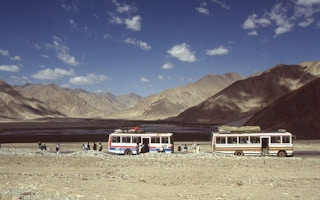China’s massive Asian infrastructure network of proposed new roads and railways, new ports and airports, linking 65 countries to itself must grapple with the same problem as the ancient Silk Road it has been named after. Sand.
Deserts present as big a problem along the “Silk Road Economic Belt” and the shores of the “21st Century Marine Silk Road” as when camel caravans ambled across Central Asia in the Tang Dynasty.
At a June event in Beijing to mark World Day to Combat Desertification, Yong Liqiang, deputy head of the State Forestry Administration, highlighted the scale of existing desertification, soil degradation and drought in more than 60 of the 65 countries covered by the One Belt, One Road (OBOR) strategy.
Chinese officials acknowledge the risks of exacerbating the problem, though policies to prevent fresh damage have not yet been developed. Meanwhile, specialist Chinese companies see tackling the risks of desertification as a commercial opportunity.
Home and abroad
The OBOR strategy covers Central, North and South Asia and the Middle East. Kyrgyzstan, Mongolia, Pakistan and Egypt, are among the worst affected countries on the routes.
They also pass through seven Chinese provinces badly affected by desertification, according to the State Forestry Administration. They are are mostly in the arid northwest, where 95 per cent of China’s deserts are.
In a report on the state of the environment in OBOR regions, the Ministry of Science and Technology highlighted desertification problems in four of the strategy’s six major economic corridors.
The report noted 400 kilometres of the China-Mongolia-Russia corridor passes through desert. Half of the 6,000 kilometre long China-Central Asia-Western Asia economic corridor is desert. Drought and desertification are the major environmental constraints along the New Eurasian Land Bridge (which runs from Lianyungang in coastal Jiangsu province neighbouring Shanghai, to Rotterdam in Holland).
Drought and widespread desertification were also named as the major environmental issues in the southern section of the China-Pakistan economic corridor.
The National Remote Sensing Centre of China’s Global Environmental Monitoring Report 2015 has examined land and sea environments along these routes.
“Environmental security” risks
Most countries are struggling with a combination of low levels of economic development and environmental fragility, and greater economic development will exacerbate environmental pressures, it found.
Chinese media reports say that China has announced investments of 1.04 trillion yuan (US$ 150 billion) in OBOR projects that are already under construction or planned.
Nearly half of it, or 500 billion yuan (US$75 billion), is earmarked for railways.
Road building accounts for 123.5 billion yuan (US$14.6 billion), airports, 116.7 billion yuan (US$17.5 billion), and ports and waterways 170 billion yuan (US$25.4 billion).
OBOR strategy money is pouring into sectors such as energy and mining, roads, railways, oil pipelines and telecoms networks and communications.
Construction of such infrastructure has a huge impact on the environment, according to the Chinese Academy of Social Sciences’ Centre for Regional Security Studies. Its report on a unified strategy for this ultimate mega project concluded, “Many OBOR projects may result in a range of environmental security issues.”
Key task
The Chinese government is aware of the environmental risks the flood of investment will bring. Examining the environment the route’s pass through was a key task given to the National Remote Sensing Centre in 2015.
Vice-premier Wang Yang, and the State Forestry Administration (which has responsibility for desertification issues), have both said desertification issues should be taken seriously when building infrastructure, and stronger communication and cooperation is needed to deal with it.
Promise of help
China has had some success curbing the spread of its own deserts, though they are still getting bigger. State Forestry Administration data shows that in the late 1990s the country’s deserts were expanding by 10,400 square kilometres a year. The rate of expansion has since dropped by two thirds, to 2,424 square kilometres a year.
Wang Yang has said China will do more to help developing nations prevent desertification, but gave no details of specific funding or technical support.
Chinese businesses, meanwhile, are cleaving to the maxim, “No crisis without opportunity.”
This story was published with permission from The Third Pole. Read the full story.










